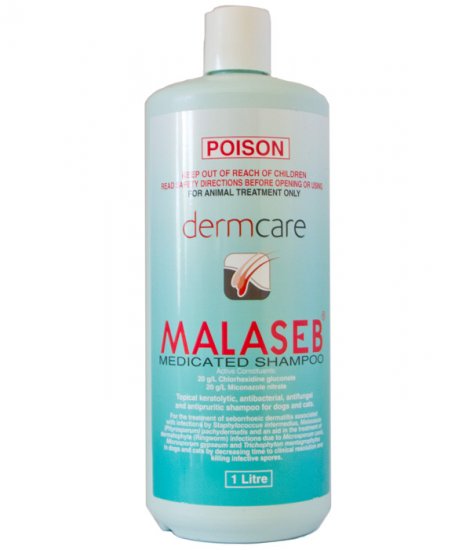Dermcare Malaseb Medicated Shampoo 1L
Dermcare Malaseb Medicated Shampoo 1L
How does Malaseb help?
- Kills the micro-organisms, helping to keep the numbers of yeasts and bacteria at manageable levels.
- Removes excess scale and oils, commonly produced when the skin is infected
- Removes allergens such as pollens which can be caught in fur or on skin causing irritation
DERMATOPHYTOSIS or ‘Ringworm’
Ringworm is the most common fungal condition in cats, however it is also a well recognised problem in dogs and horses.
Malaseb will help to sterilise the coat of ringworm spores, helping to speed recovery and prevent spread of the disease.
Ringworm in cats is a systemic disease which means that although you may only see a few spots the cat is actually covered in ringworm infection and thus all over treatment is needed.
Malaseb can be used alone or in combination with systemic medication (usually anti-fungal tablets) to treat ringworm. Combination therapy results in a faster cure than either alone.
Malaseb should be used twice weekly during ringworm treatment.
It is important if you have young children or immune-compromised adults in the same household as an infected cat that you discuss this with your veterinarian or doctor. Ringworm can have serious consequences for those without a good immune system.
How often should I apply Malaseb?
In the case of seborrhoeic dermatitis, Malaseb should be used twice weekly when the infection is active. You may be able to reduce the frequency of bathing to once per week or fortnight once the infection is under control. In most circumstances long term therapy is needed as ‘curing’ the cause of the imbalance is not always possible.
In the case of ringworm, twice weekly bathing is recommended to clean the coat of spores and infection. Therapy is typically needed for 8 to 12 weeks.
HOT TIPS
- Leave the shampoo on for the full 10 minutes wherever possible.
- Always make sure the coat is thoroughly wet before applying Malaseb, this will make lathering and spreading easier.
- Using a sponge can help to spread the shampoo well. The sponge also holds water which again helps to ensure the coat is adequately wet during application.
- A damp cloth, with a little diluted foam can be used to clean the face of both cats and dogs.
- Whilst bathing cats is never easy, many will tolerate water better if it is not running. Using a 3 bucket technique, where all buckets are filled with warm water can help. The cat is dunked (not including head) into the first bucket and shampoo applied, then wrapped in a towel for the 10 minutes to stay warm and prevent licking foam. Once the 10 minutes is up the cat is sequentially dunked into the first, then second then remaining buckets to rinse the coat.
What about conditioner?
In the case of seborrhoeic dermatitis in dogs it is recommended that after shampooing with Malaseb, Pyohex leave on conditioner be applied. This will help to achieve both the benefits of moisturising with higher antiseptic levels on the skin and coat along with an extended duration of activity.
More information:
https://dermcare.com.au/_content_data/media/PDF/Dermcare-Malaseb.pdf


